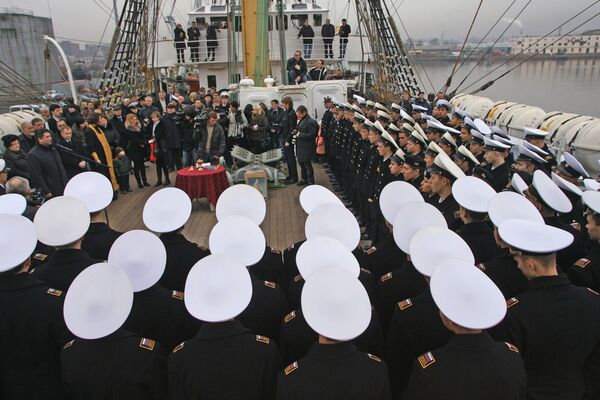Russia’s Kruzenshtern four-masted tall ship has successfully sailed through the Panama Canal and is heading for Vancouver, which is hosting the 21st Olympic Winter Games. Sergei Usankov, the ship’s first officer in charge of training, discusses the physical condition of cadets and the organization of their training in this RIA Novosti interview.
Question: Mr. Usankov, some of the cadets are on board the ship for the first time, how does the reality compare to their shore-side expectations?
Answer: An overwhelming majority of the cadets are enjoying the romance of sailing the seven seas by wind and sail, and calling at foreign ports. But they had no concrete idea of what their own role during an upcoming voyage would be. True, sailing aboard the Kruzenshtern has many romantic aspects, but they recede into the background during the first few days. And this current voyage is no exception. The cadets who felt they were ready to grapple with an Atlantic storm got seasick in the first 12 hours even though the waters were not very choppy. Many boys who are not used to picking up after themselves on shore were surprised to learn that here they have to wash their clothes, do the dishes and clean.
Q: How do you treat seasickness and how long does it take to get over it?
A: People can only speculate about their predisposition to seasickness before putting out to sea. The ship pitches and rolls as it navigates a sea or an ocean which all have their own peculiarities. Although the human body adapts quickly to some conditions, it can take years to adapt to others. It is common knowledge that not all sailors aboard the Kruzenshtern or any other ship can easily cope with its pitch and roll. However, the need to do one’s duty forces the human body to adapt. Our cadets are no different. We let them stay in bed for half a day, subsequently ordering them to assemble on deck and informing them about the ship’s layout, daily routine and safety regulations. The results are immediate. First of all, no cadet wants to flinch in front of his peers and the girls sailing with us on this voyage. Second, most of them were surprised and delighted by the salty sea winds. Their condition improved dramatically, and they did not refuse to eat dinner. As a rule, cadets who have sailed aboard the Kruzenshtern never suffer from seasickness.
Q: What does the training start with?
A: The cadets undergo a 10-day training course to prepare them for their work. They are divided according to ship masts and shifts. In time they each understand their duties on board the ship, when to do what and how to follow orders. Only then are they able to sail the ship under all of its 34 sails. At first the cadets are assisted by the boatswains and other sailors and later they can work entirely on their own. At the end of each voyage, all cadets take their qualifying exams and receive their first sea ranks, becoming first or second class sailors or engine mechanics.
Kruzenshtern cadets get their first sea rank on completing the expedition

© RIA Novosti . Igor Zarembo
/ Subscribe
Russia’s Kruzenshtern four-masted tall ship has successfully sailed through the Panama Canal and is heading for Vancouver, which is hosting the 21st Olympic Winter Games. Sergei Usankov, the ship’s first officer in charge of training, discusses the physical condition of cadets and the organization of their training in this RIA Novosti interview.



